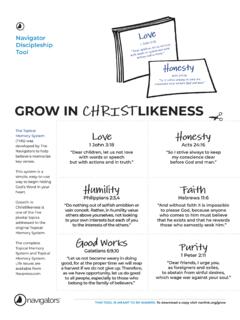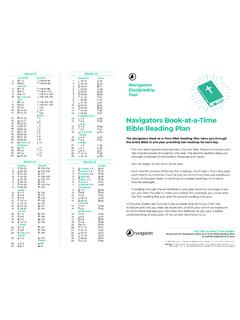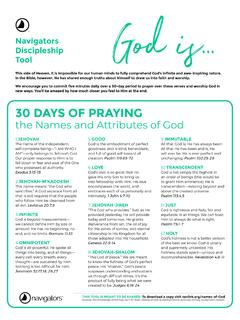Transcription of 7 Ways to Pray: Time-Tested Practices for Encountering God
1 NavigatorsDiscipleshipTool7 Ways to Pray: Time-Tested Practices for Encountering God We re always a simple word or a single step away from a conversation with God. And yet taking that step or saying that word can sometimes feel confounding or daunting. These 7 Ways to Pray draw from the deep well of Christian history to make praying a habit to enjoy in our crazy, bustling, wearying times. Praying with the Bible There are different ways to use your Bible in your prayer time. You can personalize Scripture by putting your own name into a verse.
2 For example, Amy, my peace I leave with you .. Amy, do not let your heart be troubled. (John 14:27) Try writing out a prayer f rom the Bible, adapting it into your own words. Or write the words of Scripture into a poem, just using the key words. Praying through the Bible lectio divina is Latin for sacred reading. The practice of going repeatedly through a short section of Scripture has been used for more than a thousand years. There are 4 steps reading, meditating , praying, and contemplating. Each time you go through the Bible passage, take time to pause, notice, and interact with the Holy Spirit.
3 Practicing the Presence of God Practicing the presence of God can be done anywhere and at any time. It s simply calling to mind that God dwells within us through His Spirit and His Son. Being aware of God in our daily lives takes being intentional. Welcome Jesus into whatever you are doing. You might want to set a timer at various intervals to remind yourself to call to mind the presence of Jesus. Hearing God Our Bibles burst with God speaking to His children, f rom Genesis to Revelation. One well-loved example of God s communication with young Samuel in 1 Samuel 3.
4 Samuel needed help f rom Eli, at first, to understand God. As we practice listening prayer, we can test what we hear f rom God with three helps: Scripture, impressions of the Holy Spirit, and with Lament Our prayer book in the Bible, the Psalms, bursts with songs of lament, not only those written by individuals but those for corporate worship. The psalmists cry out to God, asking and even demanding that He help them. The psalmists often move through their lament in four stages: address, complaint, request, expression of trust.
5 Follow this pattern to pen your own prayer of Imaginatively Praying imaginatively involves opening our hearts and minds to receive f rom God in a different way. We do so asking the Holy Spirit to guide and guard us. Imaginative prayer involves entering into a biblical narrative and interacting with the characters in the story, including Jesus or God the Father. Some people do this visually, as if they are in a film. For others it might be more of a journaling experience. Praying the Examen Ignatius, founder of the Jesuit order of priests, practiced a five-step process called the examen: give thanks, ask, review, repent, renew.
6 The regular practice of the examen can f ree us f rom the effects of unconfessed sin. With the examen we can also become more sensitive to discerning God s voice and moving forward with Him, as we reject our sinful desires. On the next page, there are more details on one of the seven Practices , so you can implement it in your own time with God. THIS TOOL IS MEANT TO BE SHARED. To download a copy visit f rom 7 Ways to Pray: Time-Tested Practices for Encountering God. Copyright 2021 by Amy Boucher Pye. Published by NavPress.
7 Used with permission. All rights reserved. Learn more about the book at TOOL IS MEANT TO BE SHARED. To download a copy visit f rom 7 Ways to Pray: Time-Tested Practices for Encountering God. Copyright 2021 by Amy Boucher Pye. Published by NavPress. Used with permission. All rights reserved. Learn more about the book at Discipleship ToolHow to Pray with Your Imagination: One of 7 Ways to PrayPut yourself in a Gospel story or one f rom the Old Testament. To imagine more easily, choose a story with action instead of one that focuses on Jesus teaching.
8 Get comfortable and still yourself, asking God to help you shut down any distractions coming your way. Invite Him to work through your imagination, that His Holy Spirit would fill you and direct you. That He would prevent anything f rom interfering that is not of Him so that you enjoy f reedom in the exercise. During your time of prayer, you might want to open your hands as a sign of you enter the story depends on your preferences. For instance, if you can picture things visually, you might want to imagine that you re making a film.
9 Or you might want to consider what sounds you would hear the roar of the waves of the murmur of the crowd. Perhaps you do your best imagining through feeling the emotions, such as the incensed rage of the religious leaders or the desperation of the bleeding woman. Pay attention to the details the sights, sounds, tastes, smells, and emotions. As you lose yourself in the story, meet Jesus that the aim is to encounter Christ, so try not to get distracted over the historical details let God take your imagination to reveal something about yourself or Him.
10 And know that exercising your imagination takes practice. It might not come naturally at first, but through persevering you ll find yourself more able to engage. More importantly, remember that God is with you ask Him through the Holy Spirit to guide you and spark your prayer practice can be done individually or with a group. Here are some passages suitable for imaginative prayer: Matthew 14:22-33 (Peter walks on the water) Mark 10:46-52 (The cure of Bartimaeus) Luke 5:1-11 (Jesus calls three disciples) John 13:1-17 (Jesus washes the disciples feet) Exodus 3:1-6 (Moses and the burning bush) 1 Samuel 3:1-10 (The call of Samuel)






